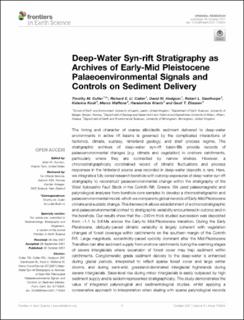Deep-water syn-rift stratigraphy as archives of Early-Mid Pleistocene palaeoenvironmental signals and controls on sediment delivery
Cullen, Tim; Collier, Richard E.L.I.; Hodgson, David M.; Gawthorpe, Robert Leslie; Kouli, Katerina; Maffione, Marco; Trygvason Eliassen, Gauti
Journal article, Peer reviewed
Published version

Åpne
Permanent lenke
https://hdl.handle.net/11250/2986811Utgivelsesdato
2021Metadata
Vis full innførselSamlinger
- Department of Earth Science [1034]
- Registrations from Cristin [9487]
Sammendrag
The timing and character of coarse siliciclastic sediment delivered to deep-water environments in active rift basins is governed by the complicated interactions of tectonics, climate, eustasy, hinterland geology, and shelf process regime. The stratigraphic archives of deep-water syn-rift basin-fills provide records of palaeoenvironmental changes (e.g. climate and vegetation) in onshore catchments, particularly where they are connected by narrow shelves. However, a chronostratigraphically constrained record of climatic fluctuations and process responses in the hinterland source area recorded in deep-water deposits is rare. Here, we integrate a fully cored research borehole with outcrop exposures of deep-water syn-rift stratigraphy to reconstruct palaeoenvironmental change within the stratigraphy of the West Xylokastro Fault Block in the Corinth Rift, Greece. We used palaeomagnetic and palynological analyses from borehole core samples to develop a chronostratigraphic and palaeoenvironmental model, which we compare to global records of Early-Mid Pleistocene climate and eustatic change. This framework allows establishment of a chronostratigraphic and palaeoenvironmental context to stratigraphic variability encountered in outcrop and in the borehole. Our results show that the ∼240 m thick studied succession was deposited from ∼1.1 to 0.6 Ma across the Early-to Mid-Pleistocene transition. During the Early Pleistocene, obliquity-paced climatic variability is largely coherent with vegetation changes of forest coverage within catchments on the southern margin of the Corinth Rift. Large magnitude, eccentricity-paced cyclicity dominant after the Mid-Pleistocene Transition can alter sediment supply from onshore catchments during the warming stages of severe interglacials where expansion of forest cover may trap sediment within catchments. Conglomeratic grade sediment delivery to the deep-water is enhanced during glacial periods, interpreted to reflect sparse forest cover and large winter storms, and during semi-arid, grassland-dominated interglacial highstands during severe interglacials. Base-level rise during minor interglacials is easily outpaced by high sediment supply and is seldom represented stratigraphically. The study demonstrates the value of integrated palynological and sedimentological studies, whilst applying a conservative approach to interpretation when dealing with sparse palynological records from proximal deep-water stratigraphy. The case study provides conceptual models where climatic and vegetation changes can begin to be incorporated as a key control on sediment flux from onshore drainage basins to deep-water syn-rift successions.
